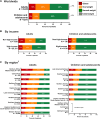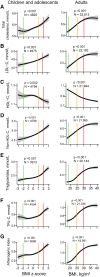Overweight, obesity, and cardiovascular disease in heterozygous familial hypercholesterolaemia: the EAS FH Studies Collaboration registry
- PMID: 39801189
- PMCID: PMC11931214
- DOI: 10.1093/eurheartj/ehae791
Overweight, obesity, and cardiovascular disease in heterozygous familial hypercholesterolaemia: the EAS FH Studies Collaboration registry
Abstract
Background and aims: Overweight and obesity are modifiable risk factors for atherosclerotic cardiovascular disease (ASCVD) in the general population, but their prevalence in individuals with heterozygous familial hypercholesterolaemia (HeFH) and whether they confer additional risk of ASCVD independent of LDL cholesterol (LDL-C) remains unclear.
Methods: Cross-sectional analysis was conducted in 35 540 patients with HeFH across 50 countries, in the EAS FH Studies Collaboration registry. Prevalence of World Health Organization-defined body mass index categories was investigated in adults (n = 29 265) and children/adolescents (n = 6275); and their association with prevalent ASCVD.
Results: Globally, 52% of adults and 27% of children with HeFH were overweight or obese, with the highest prevalence noted in Northern Africa/Western Asia. A higher overweight/obesity prevalence was found in non-high-income vs. high-income countries. Median age at familial hypercholesterolaemia diagnosis in adults with obesity was 9 years older than in normal weight adults. Obesity was associated with a more atherogenic lipid profile independent of lipid-lowering medication. Prevalence of coronary artery disease increased progressively across body mass index categories in both children and adults. Compared with normal weight, obesity was associated with higher odds of coronary artery disease in children (odds ratio 9.28, 95% confidence interval 1.77-48.77, adjusted for age, sex, lipids, and lipid-lowering medication) and coronary artery disease and stroke in adults (odds ratio 2.35, 95% confidence interval 2.10-2.63 and odds ratio 1.65, 95% confidence interval 1.27-2.14, respectively), but less consistently with peripheral artery disease. Adjusting for diabetes, hypertension and smoking modestly attenuated the associations.
Conclusions: Overweight and obesity are common in patients with HeFH and contribute to ASCVD risk from childhood, independent of LDL-C and lipid-lowering medication. Sustained body weight management is needed to reduce the risk of ASCVD in HeFH.
Keywords: Adiposity; Atherosclerosis; Dyslipidaemia; Insulin resistance.
© The Author(s) 2025. Published by Oxford University Press on behalf of the European Society of Cardiology.
Figures




References
-
- NCD Risk Factor Collaboration (NCD-RisC) . Height and body-mass index trajectories of school-aged children and adolescents from 1985 to 2019 in 200 countries and territories: a pooled analysis of 2181 population-based studies with 65 million participants. Lancet 2020;396:1511–24. 10.1016/S0140-6736(20)31859-6 - DOI - PMC - PubMed
Publication types
MeSH terms
Substances
Grants and funding
LinkOut - more resources
Full Text Sources
Medical
Miscellaneous

